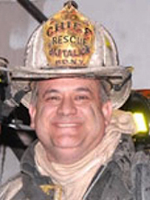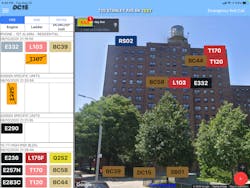Operational Readiness in an Evolving Emergency Management Environment
Sept. 11, 2001, wasn’t only a defining event for the nation but a day that forever will be etched in the memory of New York City’s firefighters. Of the nearly 3,000 people who perished as a result of the terrorist attacks, 343 members of the FDNY who responded to the call of duty lost their life trying to save others. While our nation began to recover and reshape its intelligence capabilities, emergency response agencies across the United States began to review their capabilities and readiness to respond to the possibility of another attack or major event in their city.
As the recovery efforts ended in May 2002, the FDNY began to focus on a review of its operational readiness and its capability to adapt to a changing emergency response environment. Areas of concern were identified, with an emphasis on the organization and the development of its members’ abilities and the department’s capability to operate in what wasn’t an all-hazards environment. Although many initiatives were considered, four areas that directly affected the department’s operational readiness are leadership/education, training, technology and adaptability/collaboration.
Leadership/education
Although organizational leadership always has been a strength of the FDNY, the 9/11 attacks brought new and innovative educational opportunities to the department. In 2002, the Department of Justice partnered with the Naval Postgraduate School to form the first master’s degree in homeland security. The Center for Homeland Defense and Security, which is based at the Naval Postgraduate School, offered graduate education to senior leadership representing the local, state, tribal, territorial and federal agencies. The flagship program, which is a master’s degree in homeland security studies, was unique, because it was one of the first online/in-residence models in government education that blended the participation of many agencies. The 18-month program focused on the development of critical thinkers within the department, emphasizing how a change to strategic thinking from strategic planning should be the critical part of an agency’s strategy formation and implementation.
Since the program’s inception, the FDNY has sent more than 70 of its members to the Center to help to refine their ability to devise and implement strategic initiatives. As a result of that, more than half of the FDNY’s senior staff are graduates of the Center’s master’s degree or executive leadership program.
In partnership with Columbia University and General Electric Corp., the FDNY Officer Management Institute is executive leadership training that’s offered to both fire and EMS officers. The seven-week program is an in-residence program that focuses on project management and team-building concepts.
The FDNY partnered with the Combating Terrorism Center at the United States Military Academy to conduct a one-week Counterterrorism Leadership Program. The program is offered to fire and EMS officers to assist them when it comes to recognizing the current threat environment and in regard to managing complex terrorist-related attacks.
Training
The Off-Site Campus Learning System offers various prerecorded classes and records a member’s participation and completion of the prescribed program.
The establishment of the Remote Tactical Training Unit brings training out of the academy and directly to the members in the field. Using various technological platforms, the Division of Training can conduct drills on site while streaming the class to off-site departmental locations, such as firehouses and EMS stations. This affords members who are working in the field direct access to some of their senior and most experienced peers on a more frequent basis than otherwise.
Training videos on a wide range of operational and health/safety-related topics that are relevant to both fire and EMS are produced at the fire and EMS academies and may be viewed at work on the Diamondplate computer-based platform.
Using both hands-on and class-based instruction, the Emergency Response Plan Unit offers weekly classes on terrorist-related trends and threats.
Technology
After 9/11, the department outlined a plan to modernize electronic communications. Several initiatives enabled members to communicate both internally and externally in almost any environment.
In 2012, the Motorola XTS 3500 handie talkie that was in use in the field reached its end of life. After extensive research, testing and evaluation, Motorola’s XTS 8000 was deployed throughout the department. The new capabilities that are afforded by the new radio include:
- Multiband communication in VHF, UHF and 700/800 MHz frequencies, which enhances interoperability with other agencies; FDNY has included numerous interoperability channels on those frequencies and established an interoperability protocol with all adjoining fire departments as well as many other first-responding agencies that operate within and around the city
- A multiscreen display that enables identification of members who are transmitting messages
- Display of the identity of a member who is transmitting by unit and position in plain English (alphanumeric identification)
- Voice annunciation that announces zone and channel when powering up and changing channels
- Enhanced mayday and Emergency Alert Button (EAB) activation, by which any EAB activation triggers enhanced notifications and safety measures to readily identify the member who is transmitting and to alert members who are receiving an EAB
- Retention of the last 15 mayday transmissions
- Multizone functionality that facilitates the ability to access numerous radio channels and communication systems, to allow members to monitor the NYPD, the Coast Guard, Borough Dispatch and other agencies, which can enhance situational awareness
An Auxiliary Radio Communication System (ARCS) facilitates radio communications in high-rise buildings. These systems provide a repeated radio system within the building to ensure that effective communications is possible throughout an incident. In 2014, the new NYC Fire Code 3 RCNY §511-01 (In-Building Auxiliary Radio Communication Systems) was passed. It codifies the requirement for ARCS in new high-rise buildings in New York City.
Many agencies recognize the need for such systems, and the FDNY has been coordinating with several federal and state agencies to incorporate ARCS in tunnel facilities throughout New York City.
Although the FDNY strives to address all potential communication issues that are readily apparent, there always is the unforeseen that must be accounted for. Emergencies occur in the water tunnels, the infrastructure conduits, and in large above- and below-ground areas, which makes communication difficult. The FDNY has committed to a communications project: The Kutta Radio System essentially is a portable communications repeater system. The system can be deployed readily by specially trained FDNY units to provide effective communications in any environment.
On 9/11, firefighter accountability was difficult, if not impossible, because of the large influx of firefighters coupled with the size of the incident. As a result, the department initiated the Fireground Accountability Program (FGAP).
The Emergency Fireground Accountability System (E.F.A.S.) is the foundation of the department’s FGAP, which serves as a critical goal of the department to maintain the safety and accountability of each member during incidents of whatever sort. The E.F.A.S. is one application in a suite of applications that greatly enhances fireground accountability and increases the safety of firefighters, fire officers and EMS members while they are operating on scene of a fire or other emergency incident.
E.F.A.S. is installed on the mobile data terminal that’s incorporated into the responding vehicle. It also can be carried by officers in the form of an E.F.A.S. Portable, which consists of a laptop computer that’s linked to a radio/RF modem.
When an emergency alert signal is transmitted by a member at an incident, the officer/incident commander (IC) is provided with the ability to immediately identify the member (name, company, time and riding position) who is making the emergency call. The IC quickly can dispatch the Firefighter Assist Team (FAST Unit) to effect the rescue of the down or injured member.
The accountability application also allows the IC to perform a roll call and to manually assign a member a mayday to track members in distress.
Interagency collaboration
Realizing the need for an effective and concise flow of information, the FDNY formed the Center for Terrorism and Domestic Preparedness in the summer of 2004. Since its inception, the unit has evolved into one of the premier emergency management leaders in intelligence while focusing on several operational areas. In addition to its mandate to maintain active communication across several local, state and federal agencies, strategic initiatives that are part of the unit’s realm include exercise design, weapons of mass destruction readiness and enhancements to technology of various types.
Also, the FDNY, in collaboration with the NYPD, formed an interagency rescue task force. The group consists of members of fire, EMS and NYPD operations personnel. Members of the interagency task force respond to incidents that involve aggressive deadly behavior, including active shooters, violent extremists and barricade situations. Members from fire and law enforcement who are selected for assignment to the interagency task force must undergo extensive team-based training.
Response guidance is outlined in standard operating procedures, which were developed solely for this type of interagency response.
Forefront-focused
In the 20 years that followed 9/11, the FDNY has worked diligently to maintain operational readiness while striving to remain at the forefront of innovation in areas of leadership, training, technology and collaboration.
As leaders, we’re responsible for the preparedness of those who trust us to provide the tools to operate safely and effectively. Our mission always must be to keep our departments at the forefront of emergency response innovation and advancement. At the same time, we must continually fight to fund training and education, because those two elements are the foundation of our success. The safety and readiness of our members always must remain paramount.
May we never forget the sacrifice of those first responders who ran toward danger on Sept. 11, 2001, while exhibiting bravery and unmatched heroism: the 343 FDNY firefighters, the 37 police officers of the Port Authority Police Department, the 23 police officers of the NYPD, the 8 EMTs and the 1 member of the New York Fire Patrol.
May we never forget our members of the military who perished at the Pentagon nor the thousands of civilians who were killed in the coordinated attacks.
May we always remember the men and women of the armed forces who perished while protecting our great nation along with those who leave their families to serve.
I wish to thank Assistant Chief Michael Ajello, Deputy Assistant Chief Chris Boyle, Deputy Assistant Chief Frank Leeb and Deputy Chief Michael Woods for their contributions to this article.
An App for Incident Command
- Real-time notification of incidents
- Navigation assistance and both map views and pictures of the incident location
- Display status of units that are assigned to the incident, including their arrival status
- Allows ICs to account for the location of a unit within the fireground
- Track and record a verbal roll call

Richard J. Blatus
Richard J. Blatus is a 40-year member of the FDNY who currently serves as the department's assistant chief of operations. He is a strong proponent of training who lectures on the regional and national level. Blatus holds a master’s degree in homeland security studies from the Naval Postgraduate School in Monterey, CA, as well as degrees in both fire and business administration.






